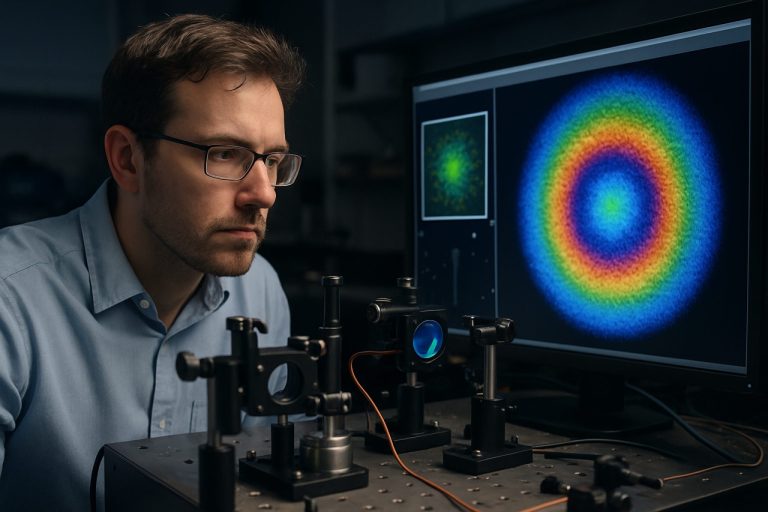
Decoding the Cytokine Landscape in Sjögren’s Syndrome: How Profiling Transforms Diagnosis and Treatment. Discover the Immune Signals Shaping Patient Outcomes.
- Introduction to Sjögren’s Syndrome and Immune Dysregulation
- The Role of Cytokines in Sjögren’s Syndrome Pathogenesis
- Techniques and Technologies for Cytokine Profiling
- Key Cytokine Signatures Identified in Sjögren’s Syndrome
- Clinical Implications: Diagnosis, Prognosis, and Therapeutic Targeting
- Challenges and Limitations in Cytokine Profiling
- Future Directions: Personalized Medicine and Biomarker Discovery
- Conclusion: The Impact of Cytokine Profiling on Sjögren’s Syndrome Management
- Sources & References
Introduction to Sjögren’s Syndrome and Immune Dysregulation
Sjögren’s syndrome is a chronic, systemic autoimmune disorder primarily characterized by lymphocytic infiltration of exocrine glands, leading to symptoms such as dry mouth and dry eyes. Beyond glandular involvement, the disease often manifests with systemic features, reflecting widespread immune dysregulation. Central to this dysregulation is the aberrant production and regulation of cytokines—small signaling proteins that orchestrate immune responses. Cytokine profiling in Sjögren’s syndrome has emerged as a critical tool for understanding the complex immunopathology underlying the disease. By quantifying and characterizing the spectrum of cytokines present in patient serum, saliva, and affected tissues, researchers can identify specific immune pathways that are activated or suppressed in different disease stages and phenotypes.
Studies have consistently demonstrated elevated levels of pro-inflammatory cytokines such as interferon-gamma (IFN-γ), tumor necrosis factor-alpha (TNF-α), interleukin-6 (IL-6), and type I interferons in patients with Sjögren’s syndrome, implicating both innate and adaptive immune responses in disease pathogenesis. These cytokine signatures not only provide insight into the mechanisms driving glandular dysfunction and systemic manifestations but also offer potential biomarkers for disease activity, prognosis, and therapeutic response. Furthermore, cytokine profiling supports the development of targeted therapies aimed at modulating specific immune pathways, moving toward a more personalized approach to disease management. Ongoing research continues to refine our understanding of cytokine networks in Sjögren’s syndrome, with the goal of improving diagnostic accuracy and patient outcomes National Institute of Arthritis and Musculoskeletal and Skin Diseases, National Center for Biotechnology Information.
The Role of Cytokines in Sjögren’s Syndrome Pathogenesis
Cytokines play a pivotal role in the pathogenesis of Sjögren’s syndrome (SS), orchestrating the complex immune responses that drive glandular inflammation and systemic manifestations. In SS, both innate and adaptive immune cells infiltrate exocrine glands, where they secrete a variety of cytokines that perpetuate tissue damage and dysfunction. Notably, elevated levels of pro-inflammatory cytokines such as interleukin-6 (IL-6), tumor necrosis factor-alpha (TNF-α), and interferon-gamma (IFN-γ) have been consistently detected in the saliva, serum, and glandular tissues of SS patients. These cytokines contribute to the recruitment and activation of lymphocytes, leading to the characteristic lymphocytic infiltration and destruction of salivary and lacrimal glands National Institute of Arthritis and Musculoskeletal and Skin Diseases.
Type I and II interferons, particularly IFN-α and IFN-γ, are central to the disease’s immunopathology, promoting the expression of interferon-stimulated genes and the production of autoantibodies. Additionally, B-cell activating factor (BAFF) is upregulated in SS, supporting B-cell survival and autoantibody production, which are hallmarks of the disease National Center for Biotechnology Information. The dysregulated cytokine milieu not only sustains local glandular inflammation but also contributes to systemic features and increases the risk of lymphoma in affected individuals.
Cytokine profiling in SS has thus emerged as a valuable tool for elucidating disease mechanisms, identifying biomarkers for diagnosis and prognosis, and guiding the development of targeted therapies aimed at modulating specific cytokine pathways.
Techniques and Technologies for Cytokine Profiling
Cytokine profiling in Sjögren’s syndrome (SS) has advanced significantly with the development of sensitive and multiplexed analytical techniques. Traditional enzyme-linked immunosorbent assays (ELISA) remain widely used for quantifying individual cytokines in serum, saliva, or tear samples due to their specificity and ease of use. However, the complexity of SS pathogenesis, involving multiple cytokines and chemokines, has driven the adoption of multiplex bead-based immunoassays, such as Luminex xMAP technology, which enables simultaneous quantification of dozens of cytokines from minimal sample volumes. This approach enhances throughput and provides a broader immunological snapshot, crucial for understanding the multifactorial nature of SS inflammation.
Flow cytometry-based intracellular cytokine staining allows for the identification of cytokine-producing cell subsets, offering insights into the cellular sources of inflammation. More recently, high-throughput proteomic platforms, including mass spectrometry and proximity extension assays (PEA), have been employed to discover novel cytokine biomarkers and profile low-abundance proteins with high sensitivity and specificity. These technologies are complemented by transcriptomic approaches, such as RNA sequencing, which can reveal cytokine gene expression patterns in affected tissues or peripheral blood mononuclear cells.
The integration of these advanced technologies has enabled a more comprehensive and dynamic understanding of cytokine networks in SS, facilitating biomarker discovery and the identification of therapeutic targets. Standardization of sample collection, processing, and data analysis remains essential to ensure reproducibility and comparability across studies, as emphasized by organizations such as the National Institutes of Health and the U.S. Food and Drug Administration.
Key Cytokine Signatures Identified in Sjögren’s Syndrome
Recent advances in cytokine profiling have elucidated distinct cytokine signatures associated with Sjögren’s Syndrome (SS), offering insights into its pathogenesis and potential therapeutic targets. Notably, elevated levels of type I interferons (IFN-α/β) and type II interferon (IFN-γ) are consistently observed in both peripheral blood and salivary gland tissues of SS patients. This “interferon signature” is linked to increased expression of interferon-stimulated genes, contributing to glandular inflammation and autoimmunity Nature Reviews Rheumatology.
Pro-inflammatory cytokines such as interleukin-6 (IL-6), tumor necrosis factor-alpha (TNF-α), and interleukin-17 (IL-17) are also upregulated in SS, correlating with disease activity and severity. IL-6, in particular, is implicated in B cell hyperactivity and autoantibody production, while IL-17-producing Th17 cells are enriched in affected tissues, promoting chronic inflammation National Center for Biotechnology Information.
Additionally, chemokines like CXCL13 and CXCL10 are elevated, facilitating lymphocyte recruitment and ectopic germinal center formation within salivary glands. Anti-inflammatory cytokines, such as IL-10, may also be increased, possibly reflecting a compensatory response to ongoing inflammation. The interplay between these cytokines shapes the immunopathological landscape of SS, underscoring the heterogeneity of immune responses among patients American College of Rheumatology.
Overall, cytokine profiling in SS reveals a complex network of pro- and anti-inflammatory mediators, with specific signatures offering promise for biomarker development and personalized therapeutic strategies.
Clinical Implications: Diagnosis, Prognosis, and Therapeutic Targeting
Cytokine profiling in Sjögren’s syndrome (SS) has emerged as a valuable tool with significant clinical implications for diagnosis, prognosis, and therapeutic targeting. Traditional diagnostic criteria for SS rely on clinical symptoms, serological markers, and histopathology, but these approaches often lack sensitivity and specificity, particularly in early or atypical cases. Cytokine profiling offers a more nuanced approach by identifying distinct patterns of immune dysregulation, such as elevated levels of interferon-gamma (IFN-γ), interleukin-6 (IL-6), and B-cell activating factor (BAFF), which are frequently observed in SS patients. These cytokine signatures can help differentiate SS from other autoimmune conditions and may facilitate earlier and more accurate diagnosis National Institutes of Health.
From a prognostic perspective, specific cytokine profiles have been associated with disease severity and the risk of extraglandular manifestations, such as lymphoma development. For example, persistently high levels of BAFF and type I interferons have been linked to increased B-cell activity and a higher risk of lymphoproliferative complications National Institutes of Health. Monitoring these cytokines may thus inform risk stratification and guide clinical surveillance strategies.
Therapeutically, cytokine profiling enables a precision medicine approach by identifying patients who may benefit from targeted therapies. Agents that inhibit BAFF, IL-6, or interferon pathways are under investigation, and cytokine signatures can help select appropriate candidates and monitor therapeutic response. Overall, integrating cytokine profiling into clinical practice holds promise for improving the management and outcomes of patients with Sjögren’s syndrome U.S. Food & Drug Administration.
Challenges and Limitations in Cytokine Profiling
Cytokine profiling in Sjögren’s syndrome (SS) offers valuable insights into disease mechanisms and potential biomarkers, but several challenges and limitations hinder its clinical application. One major challenge is the heterogeneity of SS itself; patients exhibit diverse clinical manifestations and disease severities, which can lead to significant variability in cytokine expression profiles. This heterogeneity complicates the identification of consistent cytokine signatures that are broadly applicable across patient populations National Institute of Arthritis and Musculoskeletal and Skin Diseases.
Technical limitations also play a significant role. Cytokine levels in biological fluids such as serum, saliva, or tears are often low and may fluctuate due to circadian rhythms, sample handling, or concurrent infections, making accurate quantification challenging. Multiplex assays, while enabling simultaneous measurement of multiple cytokines, can suffer from cross-reactivity and limited sensitivity, potentially leading to false positives or negatives National Center for Biotechnology Information.
Another limitation is the lack of standardized protocols for sample collection, processing, and analysis. Variations in these procedures across studies can result in inconsistent findings and hinder reproducibility. Furthermore, most cytokine profiling studies in SS are cross-sectional, limiting the ability to assess dynamic changes over time or in response to therapy American College of Rheumatology.
Finally, while cytokine profiling holds promise for identifying biomarkers and therapeutic targets, translating these findings into clinical practice requires large, well-designed longitudinal studies and validation in independent cohorts. Addressing these challenges is essential for advancing the utility of cytokine profiling in Sjögren’s syndrome.
Future Directions: Personalized Medicine and Biomarker Discovery
The future of Sjögren’s syndrome management is poised to benefit significantly from advances in cytokine profiling, particularly in the realms of personalized medicine and biomarker discovery. As research elucidates the complex cytokine networks involved in disease pathogenesis, individualized cytokine signatures are emerging as promising tools for patient stratification, prognosis, and therapeutic targeting. High-throughput multiplex assays and single-cell technologies now enable comprehensive profiling of cytokine expression patterns in both peripheral blood and affected tissues, revealing heterogeneity among patients that may underlie differences in clinical manifestations and treatment responses.
Personalized medicine approaches aim to leverage these cytokine profiles to tailor interventions based on a patient’s unique immunological landscape. For example, patients exhibiting elevated levels of interferon-inducible chemokines or specific interleukins may benefit from targeted biologic therapies, while others with distinct cytokine signatures might require alternative strategies. The identification of robust, reproducible cytokine biomarkers could also facilitate earlier diagnosis, predict disease progression, and monitor therapeutic efficacy, ultimately improving patient outcomes and reducing unnecessary exposure to ineffective treatments.
Ongoing collaborative efforts, such as those supported by the National Institutes of Health and the European Alliance of Associations for Rheumatology (EULAR), are accelerating the discovery and validation of cytokine-based biomarkers. Integration of cytokine profiling with other omics data and clinical parameters holds promise for developing comprehensive predictive models. As these technologies mature, they are expected to transform the clinical management of Sjögren’s syndrome, ushering in an era of precision medicine tailored to the immunopathological nuances of each patient.
Conclusion: The Impact of Cytokine Profiling on Sjögren’s Syndrome Management
Cytokine profiling has emerged as a transformative tool in the management of Sjögren’s syndrome, offering insights that extend beyond traditional diagnostic and monitoring approaches. By characterizing the unique cytokine signatures associated with disease onset, progression, and response to therapy, clinicians can achieve a more nuanced understanding of individual patient profiles. This precision enables earlier diagnosis, more accurate prognostication, and the potential for tailored therapeutic interventions that target specific inflammatory pathways implicated in Sjögren’s syndrome pathogenesis. For instance, elevated levels of interferon-gamma, interleukin-6, and B-cell activating factor have been linked to more severe glandular and extraglandular manifestations, guiding the selection of biologic agents and immunomodulatory therapies National Institutes of Health.
Furthermore, cytokine profiling facilitates the identification of patient subgroups who may benefit from emerging targeted treatments, such as monoclonal antibodies against specific cytokines or their receptors. This stratification is crucial for advancing personalized medicine in Sjögren’s syndrome, reducing unnecessary exposure to broad immunosuppression, and improving overall patient outcomes American College of Rheumatology. As research continues to refine cytokine panels and integrate them with other biomarkers, the clinical utility of cytokine profiling is expected to expand, supporting more dynamic and responsive disease management strategies. Ultimately, the integration of cytokine profiling into routine clinical practice holds promise for transforming the care landscape for individuals living with Sjögren’s syndrome.
Sources & References
- National Institute of Arthritis and Musculoskeletal and Skin Diseases
- National Center for Biotechnology Information
- National Institutes of Health
- Nature Reviews Rheumatology
- American College of Rheumatology
- European Alliance of Associations for Rheumatology (EULAR)



